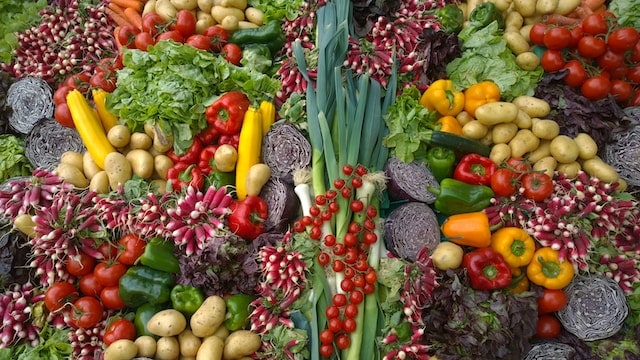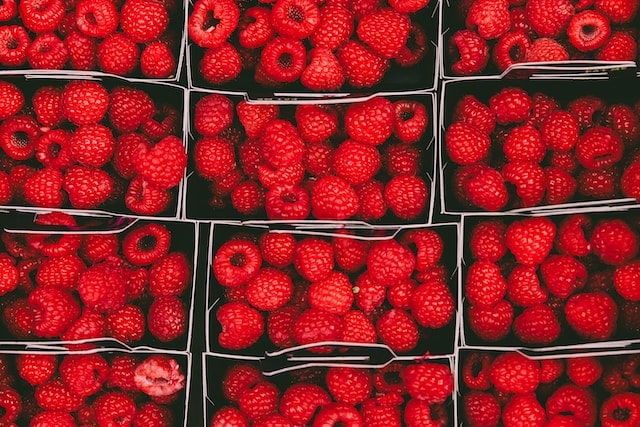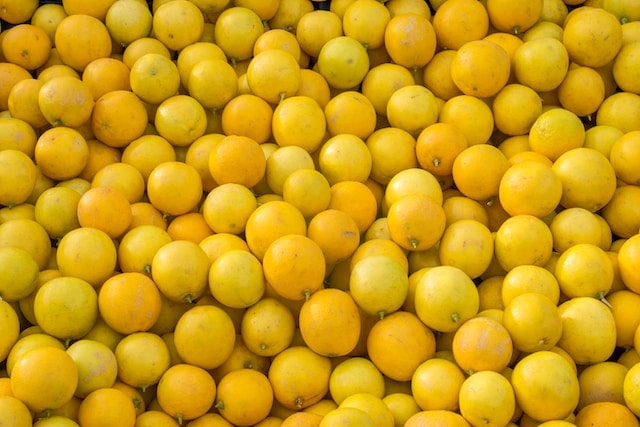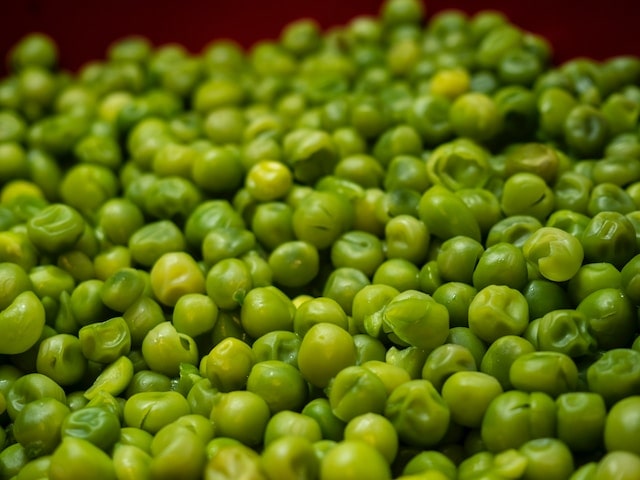

 Different pigments, referred to as phytonutrients, are found in plants and are responsible for their color. Plants of various hues are associated with higher concentrations of specific nutrients and positive health effects.
Different pigments, referred to as phytonutrients, are found in plants and are responsible for their color. Plants of various hues are associated with higher concentrations of specific nutrients and positive health effects.
While increasing your intake of fruits and vegetables is generally a good idea, focusing on a diverse range of colors can significantly enhance your nutrient intake and benefit your health in numerous ways. Including a variety of colorful foods in your diet provides your body with a wide range of vitamins, minerals, and phytochemicals, promoting overall health and well-being.
In this article, we’ll explore the advantages of incorporating foods of different colors into your diet.

Red foods not only add vibrant color to your dishes but also offer a multitude of health benefits. Many red foods are rich in lycopene and anthocyanins, two antioxidants associated with various health advantages, including a reduced risk of certain diseases and improved heart health. Consuming a variety of these red foods can contribute to your overall nutrition and well-being.
Fruits:
Vegetables:
Legumes and Pulses:
Others:
Anthocyanin, an antioxidant found in red foods, possesses potent anti-inflammatory properties, benefiting blood vessels and joints.
Lycopene, also present in red foods, gives them their distinctive red color and helps combat oxidative stress in the body, which is linked to various health issues, including high cholesterol, heart disease, and diabetes.
Red foods also provide essential vitamins like vitamin C, which strengthens the immune system and helps regulate blood pressure.
Increasing your consumption of red foods is not a difficult task. To diversify your diet, aim to incorporate a variety of naturally colored items into each meal. Boost your intake of red polyphenols by adding red berries to your breakfast porridge or incorporating tomatoes into your dinner recipes.

Yellow foods derive their color from a variety of chemicals, including carotenoids, anthocyanins, and betalains. However, carotenoids are the primary contributors to the vibrant yellow hues of most yellow foods. Unlike their orange counterparts, yellow peppers, tomatoes, citrus fruits, and carrots tend to retain their color even after cooking.
Betalains, found in beets, chard, and cactus fruit, are unique to these foods and are known for their intense colors and stability. Some yellow foods also owe their color to anthocyanins, which, while more delicate than red and purple anthocyanins, still provide a subtle hue.
Fruits:
Vegetables:
Legumes:
Yellow foods offer a range of nutrients and health benefits. Each of these foods contains a unique combination of phytonutrients, vitamins, and minerals that can enhance overall health.
For instance, bananas and yellow bell peppers are high in potassium, a vital mineral for a balanced diet.
Fruits like lemons and mangoes are rich in vitamin C, which boosts the immune system, improves skin health, and positively affects cholesterol and blood pressure.
Yellow foods also contain bioflavonoids, known as vitamin P, which aid in collagen formation and skin rejuvenation.
Incorporating more yellow foods into your diet can be enjoyable and rewarding. Here are some practical ways to include more yellow foods in your meals:
Breakfast:
Smoothies: Blend ripe bananas, mangoes, or pineapples with yogurt, milk, or almond milk.
Cereals: Add sliced bananas or golden raisins to your morning cereal or oatmeal.
Pancakes/Waffles: Top them with a tropical fruit salad made of pineapple, mango, and banana.
Lunch:
Salads: Incorporate corn, yellow bell peppers, or yellow cherry tomatoes into your salads.
Wraps & Sandwiches: Include slices of yellow bell pepper, yellow tomatoes, or even a pineapple slice in your chicken or turkey wrap/sandwich.
Soups: Try corn chowder or butternut squash soup, both of which have a golden-yellow hue.
Dinner:
Stir-Fry: Utilize yellow bell peppers, sweet corn, and yellow zucchini in stir-fry dishes.
Grilled Dishes: Grill yellow bell peppers, corn on the cob, or pineapple slices as side dishes or additions to the main course.
Pasta & Risotto: Add yellow tomatoes or yellow bell peppers. Consider dishes that use saffron, which imparts a golden-yellow color.
Roasted Veggies: Roast yellow bell peppers, yellow potatoes, or yellow beets for a healthy snack.
Desserts:
Fruit Tarts: Incorporate yellow fruits like bananas, mangoes, and pineapples.
Ice Cream & Sorbets: Look for or make flavors like mango, banana, or pineapple.
Puddings: Enjoy banana pudding or saffron-infused rice pudding as delightful yellow desserts.
Drinks:
Juices: Opt for pineapple juice, mango juice, or a blend of the two.
Turmeric Latte: Indulge in a “Golden Milk” made with milk (or almond milk), turmeric, honey, and a pinch of black pepper.
Teas: Savor lemon tea or chamomile tea.
Remember, variety is key. Consuming a range of yellow foods ensures you benefit from the different nutrients each one offers. Plus, the vibrant color they add to dishes can make meals more appetizing and enjoyable.

A healthy diet must include green vegetables, which contain a substance called chlorophyll responsible for their green color. These green foods offer a wealth of nutrients, including vitamins, minerals, and antioxidants.
Incorporating them into your diet promotes a healthier and more fulfilling life. Green vegetables, especially leafy greens, provide essential nutrients such as vitamin C, folate, calcium, iron, and other minerals.
Fruits:
Vegetables:
Grains and Seeds:
Herbs:
Others:
Green foods are rich in heart-healthy nutrients such as vitamin K, magnesium, nitrates, and folate.
They also contain polyphenols, which are abundant in dark leafy greens and possess antioxidant properties that protect the heart from disease.
Nitrates, found in green vegetables, are associated with a lower risk of cardiovascular disease death.
Additionally, green foods have an alkalizing effect on the body, helping to balance its pH levels and reduce acidity caused by factors like processed foods, stress, and lack of exercise. Maintaining an alkaline balance can prevent low energy, inflammation, and degenerative diseases.
Incorporating more green foods into your daily diet is both enjoyable and beneficial. Here are some ideas to help you incorporate more green into your meals:
Breakfast:
Smoothies: Blend spinach, kale, or avocado with fruits, yogurt, or almond milk.
Omelettes: Add spinach, green bell peppers, zucchini, and herbs like chives or cilantro.
Toast: Top whole-grain toast with smashed avocado, a sprinkle of salt, and a drizzle of olive oil.
Lunch:
Salads: Choose a base of mixed greens, arugula, or baby spinach. Add peas, green beans, cucumbers, and green bell peppers.
Wraps & Sandwiches: Include lettuce, spinach, cucumber, and avocado. Use pesto as a spread.
Soups: Opt for green vegetable-based soups like spinach, broccoli, zucchini, or green pea soup.
Dinner:
Pasta: Create pesto pasta using fresh basil or try spinach pasta.
Stir-Fry: Incorporate bok choy, broccoli, snap peas, and green bell peppers into your stir-fry dishes.
Main Dishes: Serve grilled or baked proteins with sides of asparagus, Brussels sprouts, or sautéed kale.
Rice and Grains: Mix cooked rice or quinoa with herbs, peas, or chopped greens for added color and nutrition.
Desserts:
Frozen Treats: Make popsicles or ice cream using matcha (green tea powder) or avocado.
Fruit Salad: Add kiwi and green grapes to a refreshing fruit salad.
Drinks:
Teas: Choose green tea or matcha lattes.
Juices: Juice kale, spinach, celery, cucumber, and green apple for a nutrient-packed green juice.
Water: Infuse your water with slices of cucumber, mint, and lime for a refreshing drink.
Herbs:
Enhance the flavor of dishes with green herbs like basil, parsley, cilantro, dill, and mint.
Add fresh herbs to salads, sandwiches, soups, and various dishes for an aromatic boost.
Adopt Green Superfoods:
Incorporate superfoods like spirulina, chlorella, wheatgrass, or moringa into your smoothies or dishes. By incorporating these strategies and integrating green foods into your daily routine, you’ll not only enhance the color of your meals but also boost their nutritional value.
In conclusion, adopting a diet rich in red, yellow, and green foods is a delightful and practical way to improve your overall health and well-being. By harnessing the specific nutrients, antioxidants, and health benefits offered by each color palette, you can promote optimal health, vitality, and longevity.
Remember that variety is crucial; aim to include a rainbow of colors in your daily meals to ensure you reap the full spectrum of nutritional benefits. Embrace the colorful world of red, yellow, and green foods, savor their flavors, and enjoy their health advantages.